
5 of the Best Day Walks in the Great Ocean Walk Region
For those that are aware, the Great Ocean Walk region has far more to offer than just the 12 Apostles. The areas diverse landscape, a combination of glorious coastal scenery and endemic forest, massive swells of the Southern Ocean pounding the towering escarpments and the pristine beaches create a walking experience like no other in Australia. The stunning Otway Mountains also provide a magnificent backdrop to the coast, and visitors often overlook the walking in the mountains as they are fixated on the coastal walks.
Theirs is a popular misconception that walking in nature has to be like taking a crash course in deprivation. It’s clearly fake news that you have to ‘play hard’ to have an immersive nature experience. You can have that inspiring experience of walking in the wilderness, enjoying the benefits to your mental health, even on the more challenging 20km plus walks, but you don’t have to sacrifice any of your creature comforts.
You may not know that walking in nature has been scientifically proven to make you healthier psychologically, quite dramatically in fact. Hiking in nature improves your brain function, much like if you had spent time meditating. Studies have shown that both cognition and people’s overall mood are improved significantly by walking, particularly if it is in nature.
To get the greatest benefit of visiting the Great Ocean Walk region, to really unplug and explore, you will have to don your walking shoes and take the road less travelled.
1. Milanesia Gate to Moonlight Head
This walk is well off the Great Ocean Road and can be challenging to find. Follow the signs past Lavers Hill and take the Hiders Access Track and the Melanesia Track. This is the big day on the Great Ocean Walk that people often talk about as being problematic. This is not because of its’ length but due to the continual undulation. I took 5 of my mates on this walk a few years back, and it was hilarious listening to the sedentary office-bound ‘walking not so fit’ condemn the hills as if in some way it was the tracks fault. Aside from the effort, you will need to put in ( I promise there are only a few hills), it is I think, the best day on the Great Ocean Walk. It has pristine, isolated beaches, big views and forest, and lots of hopping animals. The various viewing points along the way, like at Ryans Den and the Gables, are just some of the highlights.
This area, rich and diverse in plant and animal life, has been a gathering, ceremonial and feasting place for thousands of years. Many sites and spiritual links remain today. Archaeological sites in the park show evidence that the local Gadabanud (King Parrot) people gathered shellfish and hunted game in the resource-rich area. There are many shell middens along this walk.
Walk: 17km/ 6 to 8 hours
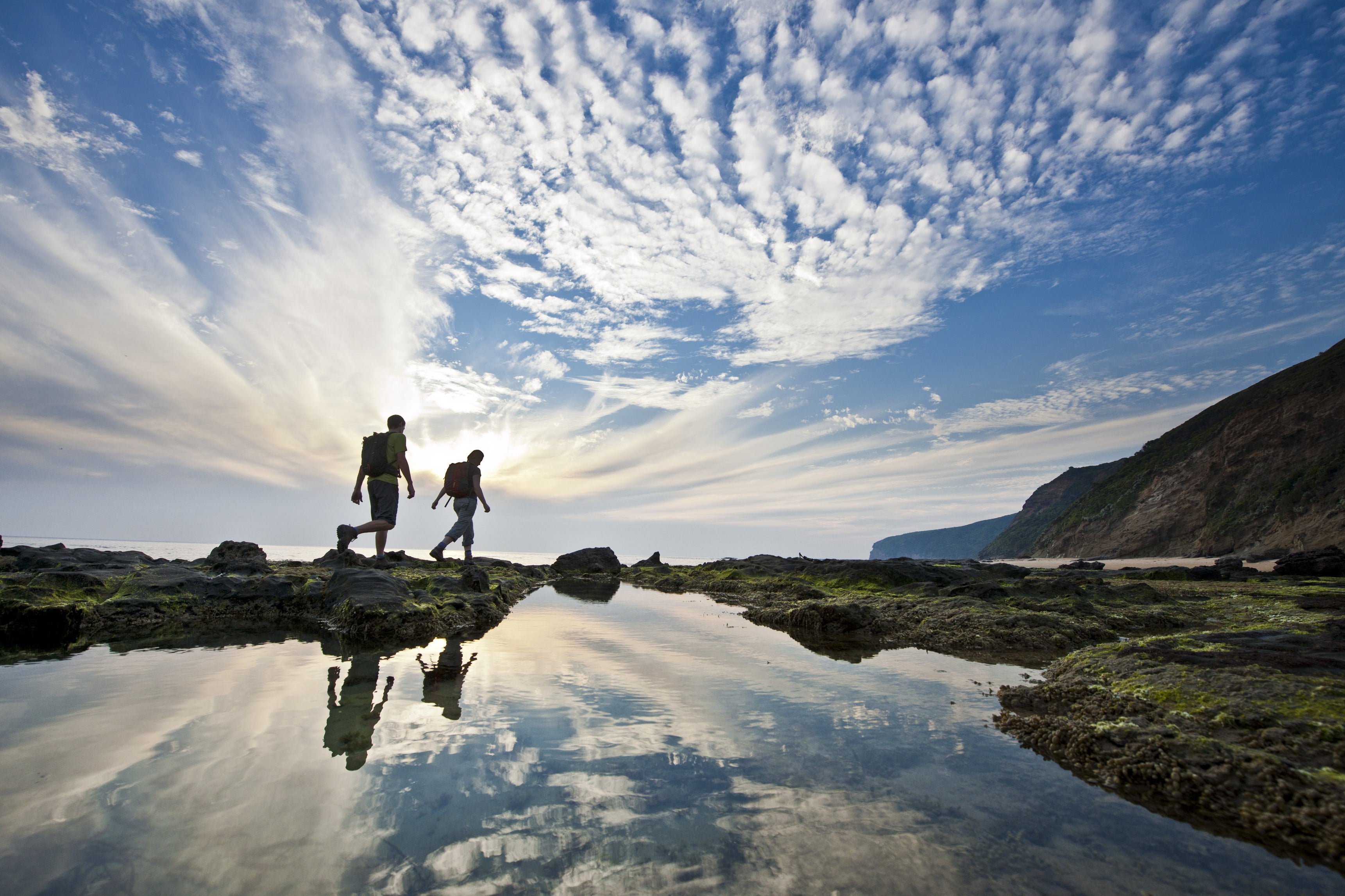
2. The Three Beech Forest Waterfalls (and Otway Fly).
These three walks are quite beautiful but receive hardly any PR, so you’re unlikely to see anyone here. That’s also because no one wants to do anything other than visit the 12 Apostles, let alone leave the coast. This means you are free to explore the three sets of falls at any pace you wish and in any way you want. The walks are all fairly short amounting to about 2.5hrs of walking in total. The drives in between each set of falls are as little as 10 minutes.
Triplet Falls & Little Aire Falls: This 1 hr walk begins with a gentle doddle through ancient endemic rainforest. After about 1.5kms you will arrive at the platform to view the creek and the cascading waterfall. Also at the falls, there is an old sawmill site. Much of the Otway Ranges forest was decimated by logging, as the long straight profile of the trees provided the perfect raw material for the sawmills.
Beauchamp Falls: The walk takes about 1 hr to complete. The forest here is packed full of Mountain Ash, the tallest flowering plant in the world, and also Myrtle and Blackwoods trees. There are also outstanding clumps of very tall tree-ferns that shade the creek. This is probably the nicest of the walks.
Hopetoun Falls – This short 30 min walk through a forest of ferns down to the falls viewing platform is well worth the little effort that it requires.
While you’re here you might want to take the 10-minute drive to the Otway Fly, said to be the highest and longest rainforest walk in the world. Beech Forest is only about 25 minutes from Apollo Bay and the signs are easy to follow to each set of falls.
Walk: Approx 7km/ 2 to 3 hours
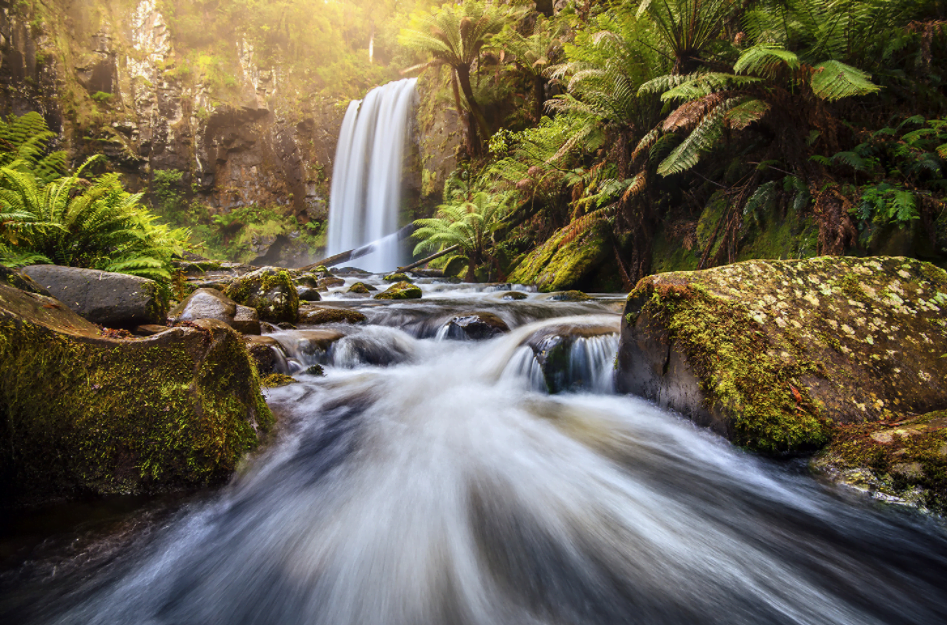
3. Castle Cove to Johanna Beach.
This is the one day where it would be good if the walk took the other direction because one of the highlights is witnessing the expansive view back to Cape Otway to the East as you walk into Castle Cove. So if you walk this track, make sure you stop and look back a few times. As a note, all walkers are required to walk from East to West on the Great Ocean Walk, which is an excellent idea as this way you hardly see anyone on the trail, unless you are extremely slow or fast. It’s worth taking your time to explore the beach at Castle Cove before setting off. From Castle Cove, the track immediately meanders through a gorgeous canopy of Tea Tree forest. It then winds its way around the coast to Johanna Beach. By the way, Castle Cove is right on the Great Ocean Road and impossible to miss.
Just before the first boot cleaning station, there’s a faint track going down to Dinosaur Cove at the top of the first hill. However, it is not that accessible to visitors in order to protect significant fossil beds. Its name comes from fossilised remains of dinosaurs, excavated from 1983 to 1993. 106 million years ago, in the days of the Gondwanaland supercontinent, this area was a broad, flat floodplain, crisscrossed by enormous meandering streams and dotted with lakes. Tall, temperate forests covered the high ground. Gondwanaland was part of the Antarctic, so for 3 months of the year, it was dark 24 hours a day! Almost 1500 fossils were extracted from here, the most common belonging to plant-eating dinosaurs sized between chickens and large kangaroos.
Walk: 8.4 kms 3 hrs
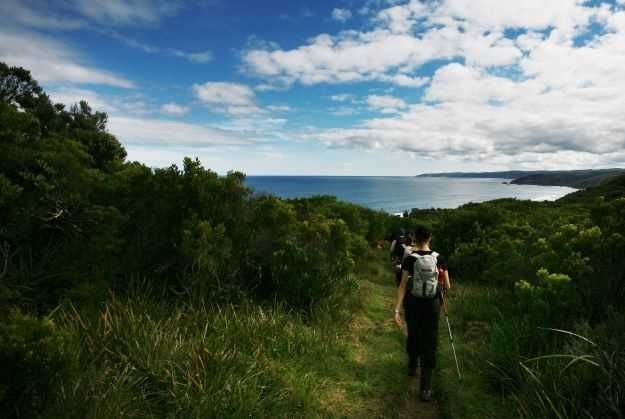
4. Gibson Steps
Beside the lookout at Gibson Steps are a set of 86 steps built in the 1800s by Hugh Gibson of Glenample Homestead to access the beach below. The walk is located just before the 12 Apostles on the Great Ocean Road. The view from the bottom of the stairs of Gog and Magog, two of the 12 Apostles, is unique and provides a marvellous perspective on the grandiosity of these world-famous limestone sea stacks. Stacks like this are formed when waves lash a headland, eroding it from both sides until an arch forms. Erosion continues until the arch collapses, leaving limestone stacks behind. The names are derived from the bible (or the Torah). Technically the names have many meanings, but the most relevant is the biblical story of Gog and Magog being both kings of the ‘unclean nations’. They were both banished, formerly excluded or driven out depending on the storyteller by Alexander the Great. Interestingly Alexander is said to have built a wall to keep them both out. The names kind of make sense when looking at the stacks from the beach, because they are awesome. The beach, by the way, is often deserted and a good place to hang out. Again the swell is big here, I’ve seen the swell at 10 metres here, so swimming is not recommended.
You can walk to the right end of the beach at low tide, then along a rocky platform, to a tunnel under the headland to the next beach where the other Apostles are. Gibson was also responsible for this ? we suppose he wanted a choice of fabulous beaches for picnics! Some years back anyone could walk through this tunnel, but the inevitable happened: after some people got stuck on the other side in a rising tide and had to be rescued, a locked gate has been now installed!
Walk: Short walk / 1 hour or less
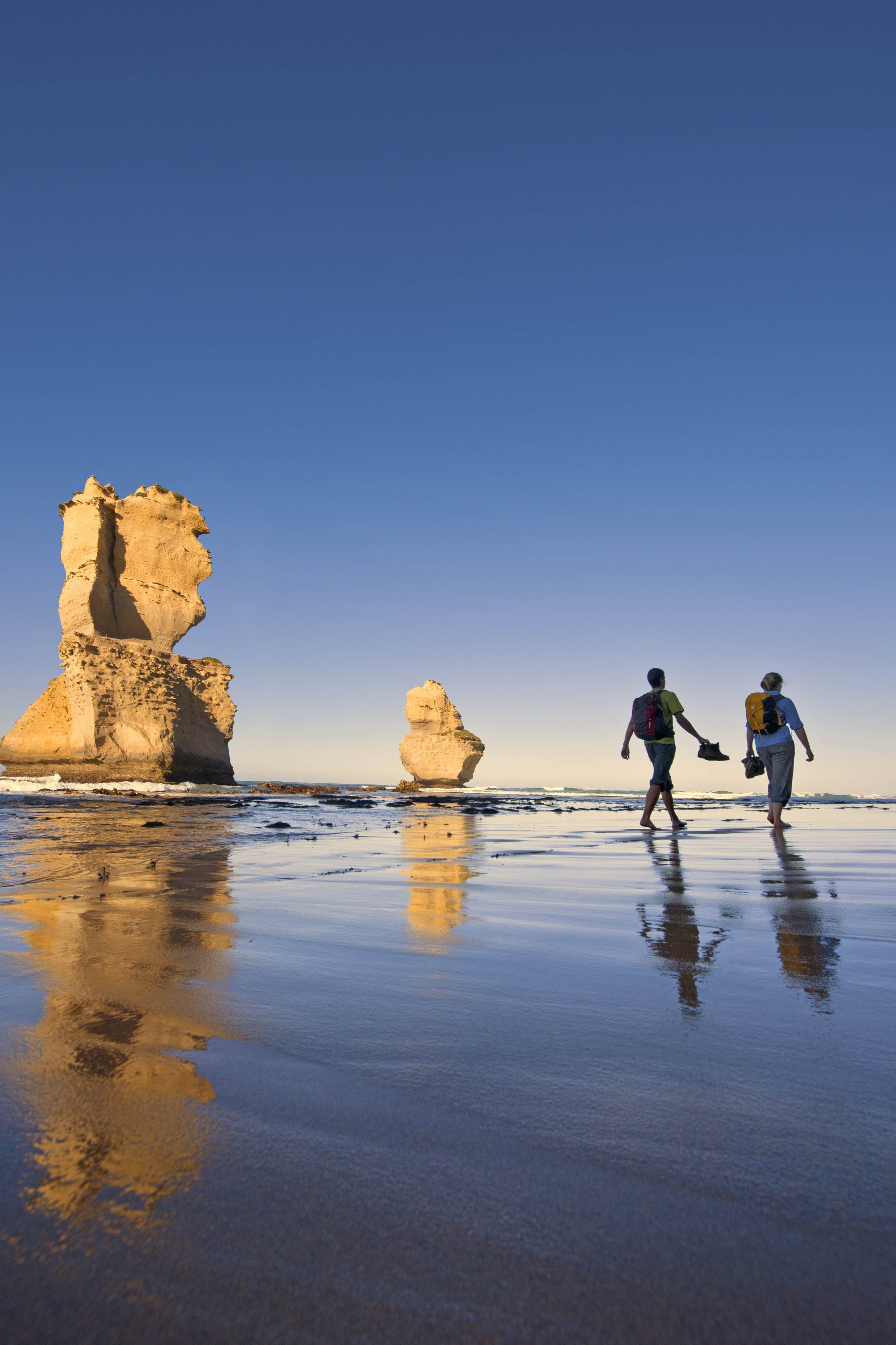
5. Shelly Beach Picnic Area to Blanket Bay.
This walk starts out through koala ‘infested’ manna gums and travels to the coast. After descending a hill to cross a watercourse, the walk immediately presents a wonderful opportunity to take a small detour to explore an extremely remote beach and rocky point. The track then heads inland via kilometres of Mountain Ash Forest or what our friends across the Tasman in Tasmania call Swamp Gum. The tree is easily recognised by it’s rough and fibrous bark at the base that changes into a smooth white or greenish/grey colour above about 15m. The trunk is long and straight and the crown open and relatively small. It sheds its bark in long ribbons, hanging from the branches. The wood is straight-grained, moderately tough and easily split and worked. It’s the world’s tallest flowering plant and second in height only to the California redwoods. These trees commonly reach 50-80m in height with some reaching 115m. All of these characteristics made them the ideal tree for early loggers.
The track breaks out onto the coast at Parkers Inlet, one of the most stunning parts of the Shipwreck Coast. It’s a short walk from here to Blanket Bay and great opportunity to take a dip. For your information, it is not advisable to swim along most of the coast as the huge swells, and the rips make it very dangerous.
Apollo Bay at the trailhead of the Great Ocean Walk is a great place to stay if you have small kids as the beach is protected from the ocean swells, and it is safe to swim. Unfortunately, much of the coast is decidedly dangerous, although there are spots like Blanket Bay and to a lesser extent Crayfish Bay where you can swim relatively safely.
Walk: 15.5 km / 4 to 5 hours
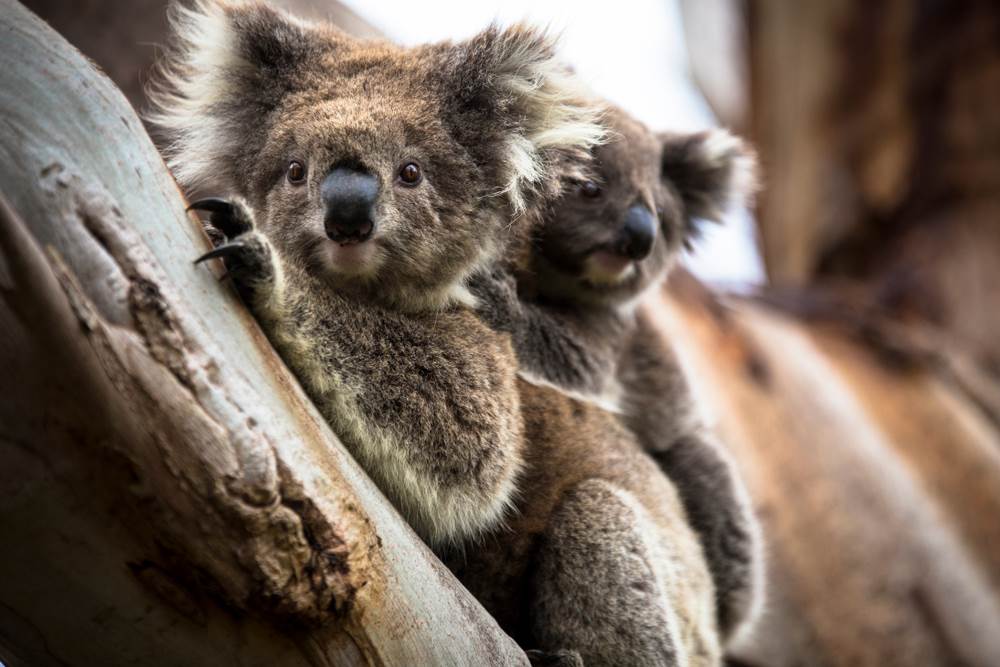
The Essentials
Getting there: The Great Ocean Walk starts in Apollo Bay. On public transport, catch a train to Geelong and swap to the connecting bus that will be waiting. This takes about 4 and half hours from start to finish. The journey from Melbourne takes about 3 hours if you drive. There are quicker ways to get to Apollo Bay by car, but the only way that makes sense is to drive the Great Ocean Road. Not only do you get to enjoy all those amazing views, it also allows you some great stops along the way, like in the lovely township of Lorne. There’s a great walk at the back of Lorne at Erikson Falls, that takes from 30min to 2 hrs depending on which tracks you choose to complete.
The walks listed range from easy to moderate to challenging. There are a plethora of other walks available in the region, but these 5 are a perfect cross-section of the landscapes and scenery that is available in the region. The walks listed can take up to 8 hours or a little as 1 hr.
The walking: The Great Ocean Walk track is probably the best-maintained track in Australia. The other tracks listed are also good. The walks range from dead easy to moderate to challenging. If you are a serious walker, you can combine days on the Great Ocean walk to make them 30km plus to make the days challenging. Although this is something I wouldn’t recommend as the beauty of this region will be lost if you rush.
What you need to take: Please make sure you take good rain gear, especially a jacket no matter what time of the year, plus warm clothes. Good walking shoes and a day pack to carry what you need are also recommended. Also, it is best to check the weather as it can get quite cold in winter or hot in summer. The best time to walk is Autumn, followed by Spring. In Autumn the days are often very still and the temperature is quite likely to be in the high teens to low 20’s, and perfect for walking.
Additional Information
Of course, the Great Ocean Walk region has a lot more on offer than just walking. There are excellent eateries in Apollo Bay and a host of accommodation options, from backpackers to premium 5-star options. Everybody is catered for, and its best to look on online to see what’s available. There’s also the option of camping in the National Park, but you must book and pay for this before you go.
If you want to eat something simple, then Apollo Bay Bakery, a bit of an institution, has its famous scallop pies (yep, scallops) and a huge range of other pies and baked products. Then at the other end of the spectrum, Chris’s Beacon Point Restaurant is decidedly upmarket. You can stay here as well in the excellent villas. Other café/restaurants of note are Casolingo, the Great Ocean Road Brewhouse, the Apollo Bay Fish co-op, and La Bimba. There’s a stack of others. There is less to choose from at the other end of the Otways at Port Campbell. Waves, 12 Rocks, Forage on the Foreshore and Grass Roots Deli are the most notable.
Then, of course, there’s the whole surf culture. In fact, when there are no swells at Bells Beach at Easter, the World Surf league shifts the Bells Beach Rip Curl Pro competition to Johanna Beach as there’s almost always surf there. There are some amazing remote spots to surf along the Otway coast, which I would be pummelled for if I give them away. But suffice to say, they’re fantastic and free from the crowds that plague the Surf Coast closer to Melbourne.
The hard sell
So you really want to walk in an extended fashion, without roughing it and like the idea of walking pack free, enjoying a glass of wine and a comfortable bed at the end of the day. Then, why not go with a tour company (like us) that provide walks on the Great Ocean Walk.
If you choose to go self-guided, we can guarantee that you will walk when you want and with who you want. We organise everything, including the transfers along the track, accommodation, and meals.
We can further enhance the experience of walking the Great Ocean Walk on a guided trip with the expertise of our local guides. As a result, you’ll get to experience a whole lot more than you could have on your own.
More info: Learn about the region and the tracks at visitvictoria.com/greatoceanwalk or at stroll.com
You can find out more about our walks here, or call us on +44 808 304 8701.
But what are your thoughts? We’d love to hear from you below if you have walked any tracks that you felt were truly inspiring.


There are no comments, be the first to comment.